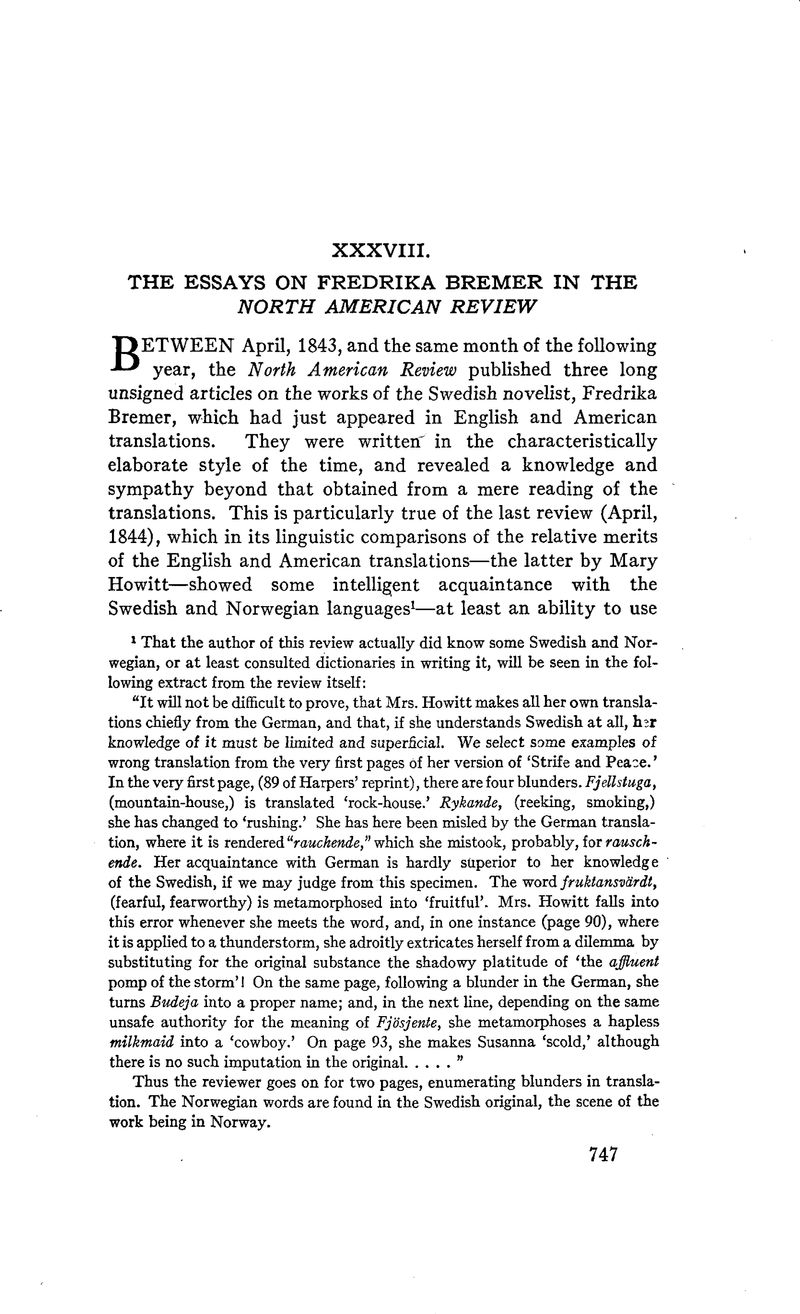Published online by Cambridge University Press: 02 December 2020

1 That the author of this review actually did know some Swedish and Norwegian, or at least consulted dictionaries in writing it, will be seen in the following extract from the review itself:
“It will not be difficult to prove, that Mrs. Howitt makes all her own translations chiefly from the German, and that, if she understands Swedish at all, h;r knowledge of it must be limited and superficial. We select some examples of wrong translation from the very first pages of her version of 'Strife and Peace.' In the very first page, (89 of Harpers' reprint), there are four blunders. Fjellstuga, (mountain-house,) is translated 'rock-house.' Rykande, (reeking, smoking,) she has changed to 'rushing.' She has here been misled by the German translation, where it is rendered ”rauchende,“ which she mistook, probably, for rauschende. Her acquaintance with German is hardly superior to her knowledge of the Swedish, if we may judge from this specimen. The word fruktansvärdt, (fearful, fearworthy) is metamorphosed into 'fruitful'. Mrs. Howitt falls into this error whenever she meets the word, and, in one instance (page 90), where it is applied to a thunderstorm, she adroitly extricates herself from a dilemma by substituting for the original substance the shadowy platitude of ‘the affluent pomp of the storm’ ! On the same page, following a blunder in the German, she turns Budeja into a proper name; and, in the next line, depending on the same unsafe authority for the meaning of Fjösjente, she metamorphoses a hapless milkmaid into a 'cowboy.' On page 93, she makes Susanna 'scold,' although there is no such imputation in the original.....”
Thus the reviewer goes on for two pages, enumerating blunders in translation. The Norwegian words are found in the Swedish original, the scene of the work being in Norway.
2 Samuel Longfellow, Life of Henry Wadsworth Longfellow, II, 10-11.
3 Ibid., p. 15.
4 Freirika Bremers Brev, samlade och utgivna av Klara Johanson och Ellen Kleman, I-IV, 1915-1920.
5 Tr. from the notes to Fredrika Bremers Brev, III, 534.
6 See my article “American Appreciation of Fredrika Bremer,” Scand. Studies and Notes, VIII, 18-19. This article contains an account of the Bremer essays in the North Am. Review, pp. 16-20.
7 It is a curious coincidence that in 1843 and 1844 both Lowell and Longfellow were afflicted with eye trouble, for which they seem to have been treated in New York by the same specialist, though without necessarily coming in contact with each other. This will account in part for the paucity of correspondence and other first-hand sources during this period. In August, 1843, as we are told, Longfellow wrote with the eyes and hands of another—his wife; and in March, 1844, he could use his eyes for only an hour or two during the day. Would he be likely to write a philological criticism, with foreign words in it, during these conditions? And it must have been in March, 1844, or earlier that the alleged Lowell contribution of the following month was being prepared. This supports the Lowell authorship, for, so far as I have been able to learn, Lowell's eyes were much better in the spring of 1844 than Longfellow's. I am mentioning this for whatever it may be worth.
8 American bibliographers have not found occasion to question the accuracy of this work. Poole's Index for 1882, obviously relies on Cushing for the authorship of the last two Bremer articles—the first article is not mentioned. P.K. Foley, American Authors 1795-1895 (1897), instead of including any articles from the North American Review under the name of a given writer, confidently refers the student to Cushing's index. Mr. Scudder, as we have seen, must have accepted Cushing's results in his Lowell biography; and in 1906 George Willis Cooke included the essay on “The New Translations of the Writings of Fredrika Bremer” (April, 1844) in his Bibliography of James Russell Lowell.
9 Cf. my article, “The Beginning of American Interest in Scandinavian Literature,” Scand. Studies and Notes, VIII, 135 ff.
10 Homes of American Authors, p. 360.
11 James Russell Lowell and Bis Friends, p. 20.
12 Lowell in his article on Witchcraft (1868) includes an account of witchcraft in Sweden—a description of the witches' flight to “Blockula” (Blåkulla) and of the executions at “Mohra” (Mora) in the seventeenth century. This article does not of course presuppose any special knowledge of Swedish, but the place names are spelled in a way that would seem to indicate the reproduction of some viva voce narrative.
13 See Ferris Greenslet, James Russell Lowell, p. 14, note. Quoted from Briggs, op. cit.
14 Cf. Gust. N. Swan, Svensk litteratur i engelsk öfversättning, in Prärieblomman for 1903 (Rock Island, Ill.), p. 211. It was in this Swedish article by the Swedish vice-consul of Sioux City, Iowa, that I first discovered the connection between “M. L. Putnam” and “Mary Lowell Putnam.” Some authorities, among them The New International encyclopedia, maintain that Mary Lowell also translated Miss Bremer's The Neighbors. Says Briggs, op. cit.: “Mrs. Putnam made the first translation into English of Fredrika Bremer's novel The Neighbors, from the Swedish. The translation by Mary Howitt was made from the German.” It is doubtful, though, that it was ever published, and if it was, it was probably anonymous.
15 North Am. Rev., April 1844, p. 484, footnote. The italics are my own.